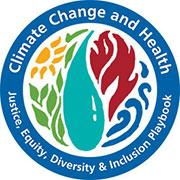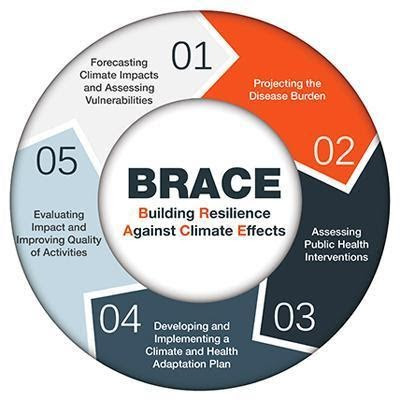 What is BRACE?
What is BRACE?
CDC is the national leader in supporting state, territorial, tribal, and local public health agencies to prepare for specific health impacts of a changing climate. As of 2020, the Climate-Ready States and Cities Initiative (CRSCI) is helping sixteen states and two cities develop ways to anticipate the health effects of climate change by applying the best climate science available, predicting health impacts, and preparing public health programs to protect their communities.
To aid public health professionals in adapting to the health effects of a changing climate, CDC created the BRACE framework. Understanding and addressing the health implications of climate change involves incorporating complex data into public health planning and response activities. This enables communities to effectively foresee, prepare for, and respond to an array of climate-sensitive health impacts.
The BRACE framework is a five-step process that helps health departments identify how climate change has and will affect human health. It enables health departments to undertake a systematic, evidence-based process to customize their planning and response to local climate and health risks and hazards.
For more information, visit www.cdc.gov/climateandhealth/climate_ready.htm.
Steps in the Brace Framework
Step 1: Forecast climate impacts and assess vulnerabilities. Identify the scope of climate impacts, associated potential health outcomes, and the populations and locations vulnerable to these health impacts.
Step 2: Project the disease burden. Quantify the additional burden of health outcomes associated with climate change
Step 3: Assess public health interventions. Identify the most suitable health interventions for the identified health impacts of greatest concern.
(image text)
Step 4: Develop and implement a climate and health adaptation plan. Develop a written adaptation plan that is regularly updated. Disseminate and oversee implementation of the plan.
Step 5: Evaluate impact and improve quality of activities. Evaluate the process. Determine the value of information attained and activities undertaken.
For more information, read Building Resilience against Climate Effects — A Novel Framework to Facilitate Climate Readiness in Public Health Agencies and/or watch this video:
BRACE's Flexibility
The BRACE Framework is flexible and can be adapted to suit the needs of those using it. For example, a large state might implement BRACE in a very different manner than a small city. Many jurisdictions and groups have adapted BRACE, both formally and informally.
The Swinomish Indian Tribal Community (Swinomish) indigenized the BRACE framework. They adapted BRACE to bring in Indigenous concepts of health and enhanced the framework’s applicability and attention to equity by incorporating a model of Indigenous values-based data collection, analysis, and decision-making. This approach defined “health” as shaped by the many interrelated relationships between humans, non-human beings, nature, local natural resources, and the spiritual realm, with a focus on familial and community scales rather than as individuals. In implementing the first step of BRACE, the Swinomish created a set of Indigenous Health Indicators, which are not usually represented in conventional public health assessments. Examples include: Community Connection; Natural Resources Security; Cultural Use and Practices; Education (the Swinomish teachings); Self-Determination; and Adaptation (7 generations). They also created a series of modules explaining the process to help aid other Tribes.
The Climate Change Workgroup of the National Association of County and City Health Officials also created an adapted version of the BRACE framework. Essential Actions for Climate Resilience in Local Health Departments is designed to aid county and city health departments, especially those with limited resources, to implement specific, measured steps to build climate adaptation in their organizations and communities.